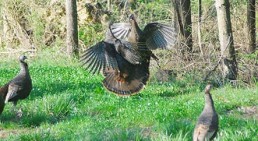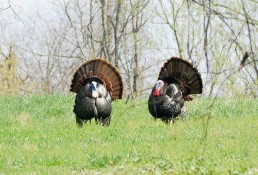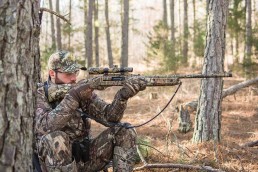To Wild Turkeys, ‘Social’ Doesn’t Always Mean Hospitable
SHARE THIS POST
The social structure of wild turkeys can be complex. Throughout any given year, when hens and toms are not mating, these elusive birds share their days in flocks of their own. Most of the time they spend their days feeding, loafing and roosting at night. But the inner social structure of turkeys often includes physical conflicts between each bird. Toms especially fight, to establish dominance throughout spring mating activities.
But did you know that hens also fight?
So, how does turkey fighting affect hunters? How often do the turkeys fight and what initiates these actions?
In a perfect world, every life form gets along. However, throughout the diverse habitats of the wild turkey, events aren’t always serene, and include dramatic physical clashes. Turkeys fight for many reasons, such mating rights, territorial usage and social intra flock structure.
Fighting establishes their pecking order. I believe pecking order could be defined as the “physical” pecking turkeys force upon each other’s neck and head as they spar to establish their social role placement.
Not many hunters are fortunate enough to view and study turkeys during a session of fighting. I watched five jakes dominate one mature gobbler. Twice, the woodland “street gang” pounded the lone mature gobbler. They used all their fighting tools: wings, spurs, beaks, body postures and aggressive vocals.
I was taking pre-hunting season turkey pictures at my Amish friend’s property, Henry Miller. There had been limited gobbling after daylight, which was abnormal. Henry had told me the birds had been active, so I became more impatient. Then, at 7:35 a.m., a loud “gobble” was heard. I waited for several minutes—then he double-gobbled.
Stroking the chalked paddle of my box call to mimic an excited hen turkey, my sequence was cut short by an approaching gobbler somewhere in front of me. No doubt, he was on the move searching for hens. I called again and he replied with a deep gobble. Then, I saw him standing at a landscape rise on one of Henry’s timber skid roads. He gobbled. I called. And he gobbled again, and I called once more. Then, he committed and began strutting down the hillside’s logging trail.
Within seconds, the real show was about to begin. I heard gobbling to my left. Not one tom, but more than one. As my intended mature gobbler continued to strut toward me, five jakes appeared from the woodland cover between the tom and myself.
No problem—this mature tom will run the jakes off. However, that wasn’t the case this time.
Are you enjoying this post?
You can be among the first to get the latest info on where to go, what to use and how to use it!
All five jakes ran at the tom like the defensive line of a pro football team. The fight was on, as each jake was going at the mature tom, one after another. I was shocked to see such an unusual spectacle. The five jakes were so aggressive I told Henry I labeled them the “Morgan County Street Gang.” The mature tom soon lost his confidence and ran into the woods. The victorious five jakes fed and strutted along the green grass skid road. I began calling to them so I could take a few pictures, but the show wasn’t over yet.
Within minutes the mature tom came in from behind me, spitting and drumming as he circled out into the open to face the jakes again. And it started all over. The jakes blitzed the tom again. Their fight was short-lived and they succeeded in forcing the mature gobbler back into he woods. I had previously only watched hens fight, but never toms, let alone a bevy of jakes overpowering a mature tom.
Was this a rare? The confrontation made me wonder how frequent fighting occurs in their social structure?
Fighting is a natural response within so-called turkey social structures. Battles between brood mates throughout the summer confirm flock pecking orders. Each turkey appears to have its place. Their individual dominance is frequently determined by fighting. Although skirmishes aren’t usually a life and death incident, defeated birds can be pretty roughed-up. Turkeys, normally, are social birds. But conflict is an affair that can establish individual status. Therefore, the results of fighting provide and ensure pecking orders are maintained.
How can turkey fighting actions and vocals be useful to hunters? I’m certain that all turkeys at some point are familiar with the sounds of what is described as the “fighting purr”—vocals produced by turkeys battling. And, if you’ve ever been at a loss when you’ve tried every call you can muster to attract a wary spring gobbler, consider this vocal.
The fighting purr is a variation of the “push-pull” call. It can be created by a single call with dual push rods or two separate calls. It has been said that the fighting purr sounds create a sudden sense of urgency within a gobbler. Because turkeys often gravitate to the sounds of other turkeys fighting, whether too watch or join the fight, fights inspire excitement in most birds. All at once, their heads can change color from white to blood red, possibly due to being agitated as their blood rushes to their heads.
The goal of a hunter and his fighting purr calling is to mimic actual turkey-fighting sounds. And, if you can rake the leaves with one hand while your using a fighting purr call, this trick can be an effective tactic for bringing in gobblers.
Hunters are not only opportunists, but we are constantly accessing more affective hunting methods. We often make conclusions to improve our successes. Therefore, I have learned to believe that gobblers, especially right before and during spring mating, are drawn to the sounds of turkey fighting between toms, as well as hens, because of pecking order dominance. It appears most turkeys like a good fight. But for a gobbler it just might be he senses an opportunity to move in on and steal any hens watching on the sidelines whenever two toms are fighting. And, if hens are experiencing a dispute, it’s another chance to meet his next mating partner.
I’ve always considered turkeys as easy-going, passive, secretive birds. But I have a new understanding of their habits after observing a small flock of these birds fighting. It’s not unusual for males of any species to have conflict over territories or regarding mating. But now when I watch a flock of toms or hens fighting, I’ve learned that not all is passive within turkey society.
MWO
SHARE THIS POST
Did you enjoy this post?
You can be among the first to get the latest info on where to go, what to use and how to use it!
Bob Grewell
Bob “Greenie” Grewell has written about and photographed the outdoors for 40 years. He’s travelled throughout the U.S., Canada, the Arctic Circle, as well as Germany and Denmark. He has written a book on hunting dogs and contributed articles and photography to others. He currently focuses on deer and turkey articles, and wildlife photography.




